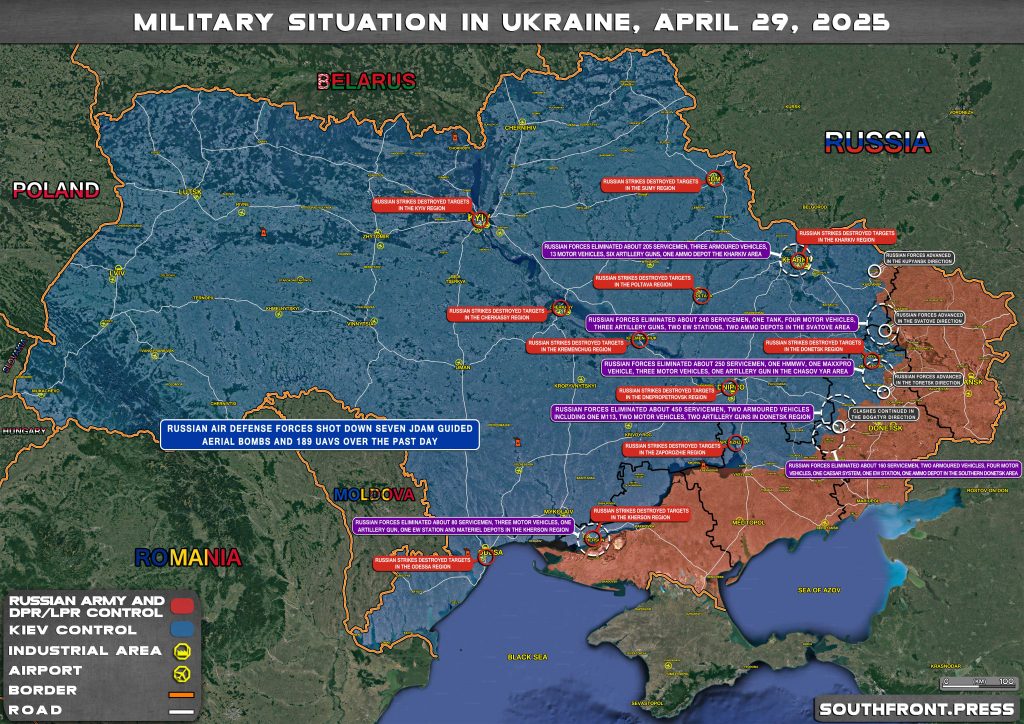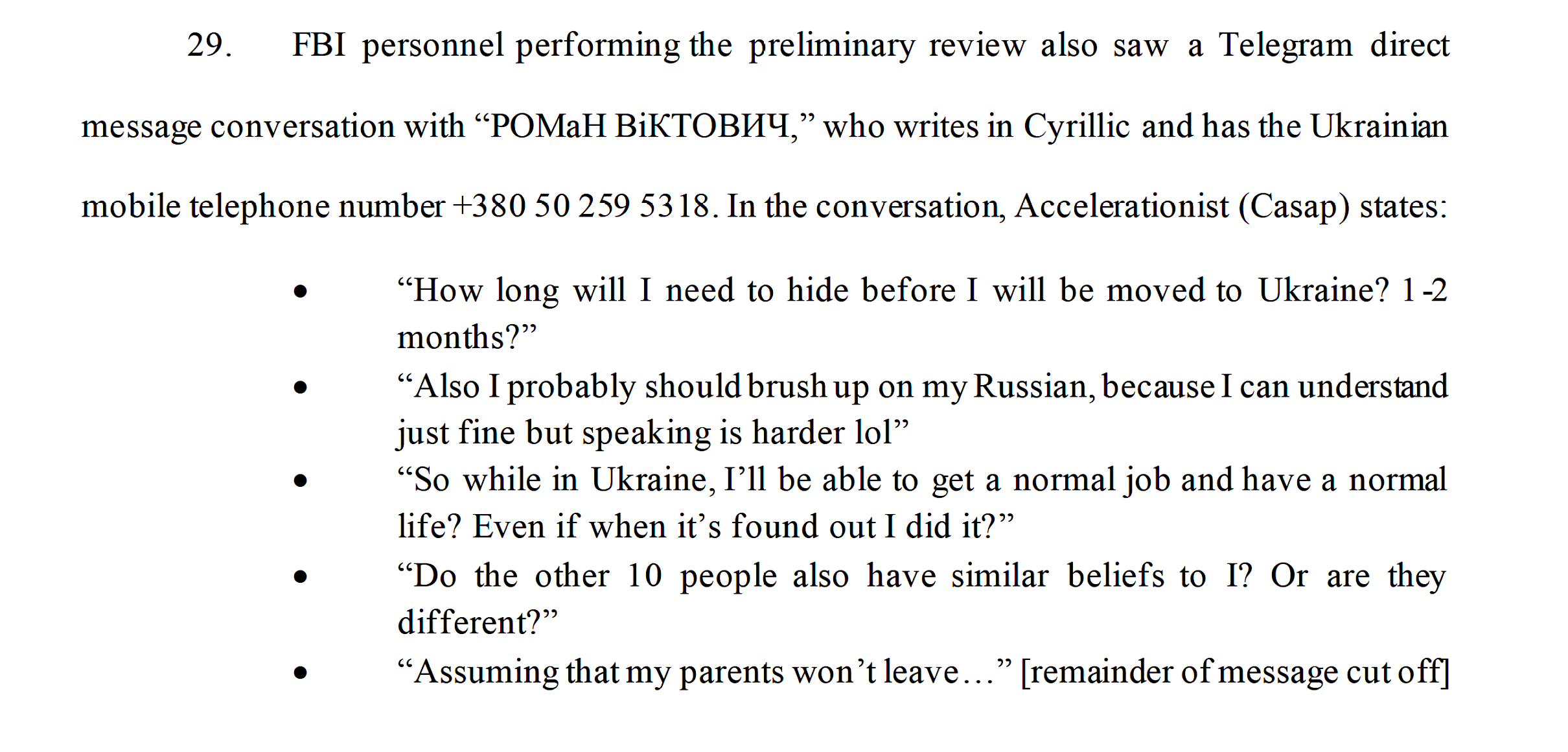By Joe Lauria, Consortium News, 4/14/25
Included in the F.B.I.’s affidavit charging a 17-year old Wisconsin teenager for murdering his parents in February and plotting to assassinate President Donald Trump with explosives dropped from a drone are the transcripts of Telegram chats the suspect had with one or more people in Ukraine.
In all three communications cited by the F.B.I., the suspect, Nikita Casap, uses the handle @accelerationist. The first transcript reads:
“@accelerationist: ‘what country do you think will get the blame for this [Trump’s assassination]?’
Unknown: Russia will be blamed for it, this is the goal.”
Casap then asks Unknown how he should send his 3-page manifesto outlying his reasons to assassinate Trump and possibly Vice President J.D. Vance: to create the needed chaos to overthrow the U.S. government and “save the white race” from “Jewish controlled” politicians. Casap asks if his manifesto will be edited and Unknown simply tells him to send him photographs of the document.
The F.B.I. then described the second Telegram conversation:
The phone number in the document is found on a Facebook page called “DIY soapmaking” with no further information other than an email address. Consortium News wrote to the address but received an “Address Not Found” response. A call placed to the number by CN indicates that the number, unsurprisingly, is no longer working.
In the third chat, Casap received instructions from someone writing in Cyrillic.
This could be either the same person or someone else in Ukraine or conceivably in Russia writing in Cyrillic. The F.B.I. reports third-hand from a classmate of Casap that Casap told him he was in contact with someone in Russia.
The F.B.I. does not make clear whether “Unknown,” “POMaH BiKTOBNWY,” and “forest” are different people. But whether one or three, they are clearly directing Casap to change his license plates, to drive from Wyoming back east to Kansas, south to Oklahoma and then west to California.
He did not make it that far however. On Feb. 28, police in WaKeeney, Kansas arrested Casap just 85 minutes after his step father’s car was listed by police as stolen. In the car was a .357 magnum revolver, jewelry, $14,000 in cash and several electronic devices.
Earlier that day police in Waukesha, Wisconsin had discovered the dead bodies of his mother, Tatiana Casap, 35, and his stepfather, Donald Mayer, 51, in the family home.
Nikita Casap had killed them both about two hours apart on Feb. 11, police determined. A neighbor saw Casap leaving with the family dog in Mayer’s SUV on Feb. 23. He had lived with his parents’ decomposing bodies for 12 days.
The F.B.I. says Casap killed them to get the financing and “autonomy” needed to carry out the assassination.
The bureau says the Telegram “messages in Russian” took place between Feb. 14, three days after police say he killed his parents, and Feb. 24, four days before he was arrested. The conversation about making it look like Russia did it took place on Jan. 25, however, according to the affidavit.
In what appears to be a possibly fourth Russian language chat with someone the F.B.I. does not identify, Casap is instructed what to do with his parents’ bodies.
“a. ‘Reply to them all and say [you] got sick.
b. ‘Take [drag] them to the basement.’”
The F.B.I. contacted Mayer’s employer who told the bureau he had not showed up for work for two weeks but had sent several messages saying that he was sick. Casap did not drag the bodies to the basement but left them where he had killed them. He covered them with blankets and was charged with “hiding a corpse” as well as plotting to kill the president.
A Plot Directed From Ukraine
One can only conclude from this early evidence that Casap was directed from Ukraine in a plot to kill Trump. The F.B.I. says Casap had already bought drones and explosives. He received instructions on how to use the drones to extend their range and avoid detection but the F.B.I does not say where these directions came from. Casap had a Telegram chat with someone named Angel of Death about purchasing a “drone with a dropping mechanism” in bitcoin for about $1,200 to $1,500. The affidavit does not say where Angel of Death is located.
We know that one or more people in Ukraine instructed Casap every step of the way: to move his parents’ bodies, to text his father’s workplace, to change the license plates on his stepfather’s SUV, to follow a circuitous route to California, and to send his manifesto to Ukraine.
Casap also communicated to them about the plan for him to settle in Ukraine once the assassination was carried out. And perhaps most significantly someone in Ukraine told him that the goal of the operation was to make it look like Russia had assassinated Trump.
At this point there is no indication who this person or persons may be in Ukraine. The F.B.I. says Casap was involved in a Satanic group. (He also praised Hitler in his manifesto.) The bureau provides chat transcripts with like-minded Satanists but none of these are said to be in Ukraine.
Eureka, California appeared to be his final destination some time in March. There’s no indication yet that he would come into possession of the drone or drones there and the explosives. Trump did not visit Eureka, the scene of several recent anti-Trump protests, in the month of March or so far in April.
Earlier Ukraine Connections
This is the second time a connection to Ukraine has arisen in a plot to assassinate Trump. Ryan Routh was arrested for attempting to kill Trump on his golf course in West Palm Beach, Florida on Sept. 15, 2024.
Routh told The New York Times and Newsweek that he flew to Ukraine in 2022 to fight but was rejected because he had no military experience and was in his mid-50s. So he turned to recruiting foreign fighters for Ukraine, but apparently failed at that too.
There is no indication Routh maintained any connection to Ukrainian authorities.
A week ago on April 8, federal prosecutors said in a court filing that in August 2024 Routh tried to purchase an anti-aircraft weapon from a Ukrainian weapons dealer which prosecutors are tieing to Routh’s surveillance of Palm Beach International airport, where candidate Trump flew into and out of.
The court filing says: “Attempting to purchase a destructive device to blow up President Trump’s airplane lies squarely within the realm of an attempt on his life, and Routh’s statements about the purpose of the purchase drives home his intent.”
He allegedly wrote to the arms dealer: “Send me an rpg [rocket-propelled grenade] or stinger [anti-aircraft missile] and I will see what we can do … [Trump] is not good for Ukraine.”
Media Downplay
Given the extent of the evidence divulged in the F.B.I.’s affidavit about the involvement by one or more persons in Ukraine in a plot to assassinate a president of the United States it should cause great wonderment why the leading media in the U.S. and abroad either downplayed or completely ignored the Ukraine connection in this story.
In the fourth paragraph of The Washington Post ‘s account we read that the F.B.I. “found messages in Russian and communications on TikTok and Telegram,” without any mention of Ukraine. It leaves the impression that the messages originated from Russia.
The 11th paragraph reads: “A review of Casap’s communications also found that he planned on leaving the United States for Ukraine after carrying out his plot.” No mention of him discussing this with someone in Ukraine, however.
As an afterthought, CNN’s account leaves it to the penultimate paragraph to say, out of the blue, with no context or explanation:
“According to the Waukesha County complaint, detectives found messages indicating Casap planned to leave the US for Ukraine. In one Telegram message, he asked, “So while in Ukraine, I’ll be able to live a normal life? Even when it’s found out I did it?”
The BBC reported without proof that Casap was in touch with people in Russia about killing his parents, that he planned to go to Ukraine and was simply “in touch” with other parties about killing Trump. It reported:
“The court documents allege the suspect was speaking with people in Russia about plans to kill his parents.
Authorities said the teenager paid for a drone and explosives to use in an attack – and had plans to escape to Ukraine.
‘He was in touch with other parties about his plan to kill the president and overthrow the government of the United States,’ investigators wrote.”
The Australian Broadcasting Corporation just stuck in the middle of its report:
“In court, prosecutors alleged the teen was in touch with a person who spoke Russian and shared a plan to flee to Ukraine.
Federal prosecutors alleged Nikita’s manifesto outlined his reasons for wanting to kill Mr Trump and included ideas about how he would live in Ukraine.”
Perhaps worst, The New York Times does not mention Ukraine once.
Neither The Guardian nor The Wall Street appear to have covered the story at all.
Joe Lauria is editor-in-chief of Consortium News and a former U.N. correspondent for The Wall Street Journal, Boston Globe, and other newspapers, including The Montreal Gazette, the London Daily Mail and The Star of Johannesburg. He was an investigative reporter for the Sunday Times of London, a financial reporter for Bloomberg News and began his professional work as a 19-year old stringer for The New York Times. He is the author of two books, A Political Odyssey, with Sen. Mike Gravel, foreword by Daniel Ellsberg; and How I Lost By Hillary Clinton, foreword by Julian Assange.
Like this:
Like Loading...


